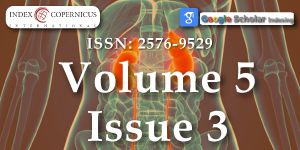The inflammatory profile of chronic kidney disease patients
Main Article Content
Abstract
Background: Chronic kidney disease is a worldwide public health issue which is associated with an increased risk of end-stage renal failure and cardiovascular disease. Systemic inflammation exists during chronic renal failure. Recent researches have highlighted the pivotal role of inflammation between renal and cardiovascular disease. The aim of our study is to determine the inflammatory profile of the patient suffering from chronic kidney disease and the influence of hemodialysis on this profile.
Methods: We carried out a cross sectional study on 93 patients in the Nephrology Department at Hedi Chaker University Hospital, Sfax, South of Tunisia. Among those patients, 72 patients underwent hemodialysis and 21 patients had chronic kidney disease at stage 3. Clinical data and antecedents were collected. Biological samples were taken after informing the patients and taking their consent. Biological data consisted in lipid profile, albumin rate, hemoglobin rate, uric acid concentration and the usual markers of inflammation noting sedimentation rate, C - reactive protein and orosomucoid.
Results: Hemodialysis group of the 72 patients had mean hemodialysis vintage of 54.6 ± 43 months. The inflammatory profile was worse in hemodialysis patients compared to chronic kidney disease patients. Both sedimentation rate, C - reactive protein and orosomucoid were higher in hemodialysis group than in chronic kidney disease group with 71 ± 35.3 mm vs. 42.1 ± 15.5 mm (p < 0.05); 14.6 ± 28.7 mg/l vs. 6.7 ± 8 mg/l (p = 0.02); 1.3 ± 0.7g/l vs. 0.9 ± 0.4 g/l (p = 0.01), respectively.
Conclusion: Inflammation increases in dialysis patient. It deserves the nephrologist’s consideration in order to minimize its harmful effects. The monitoring of inflammation markers must be integrated into the nephrologist’s medical practice.
Article Details
Copyright (c) 2021 Chaker H, et al.

This work is licensed under a Creative Commons Attribution 4.0 International License.
Udeanu M, Guizzardi G, Di Pasquale G, Marchetti A, Romani F, et al. Relationship between coronary artery disease and C-reactive protein levels in NSTEMI patients with renal dysfunction: a retrospective study. BMC Nephrol. 2014; 15: 152. PubMed: https://pubmed.ncbi.nlm.nih.gov/25230678/
González-Espinoza L, Rojas-Campos E, Medina-Pérez M, Peña-Quintero P, Gómez-Navarro B, et al. Pentoxifylline decreases serum levels of tumor necrosis factor alpha, interleukin 6 and C-reactive protein in hemodialysis patients: results of a randomized double-blind, controlled clinical trial. Nephrol Dial Transplant. 2012; 27: 2023–2028. PubMed: https://pubmed.ncbi.nlm.nih.gov/21968012/
Dekker MJE, van der Sande FM, van den Berghe F, Leunissen KML, Kooman JP. Fluid Overload and Inflammation Axis. Blood Purif. 2018; 45: 159–165. PubMed: https://pubmed.ncbi.nlm.nih.gov/29478061/
Panichi V, Scatena A, Migliori M, Marchetti V, Paoletti S, et al. Biomarkers of Chronic Inflammatory State in Uremia and Cardiovascular Disease. Int J Inflamm. 2012; 2012: 360147. PubMed: https://pubmed.ncbi.nlm.nih.gov/22701810/
Cobo G, Qureshi AR, Lindholm B, Stenvinkel P. C-reactive Protein: Repeated Measurements will Improve Dialysis Patient Care. Semin Dial 2016; 29: 7–14. PubMed: https://pubmed.ncbi.nlm.nih.gov/26360923/
Combe C. Dose de dialyse, nutrition, inflammation: quelle est la relation? Néphrologie Thérapeutique. 2010; 6: 7-12.
Cobo G, Lindholm B, Stenvinkel P. Chronic inflammation in end-stage renal disease and dialysis. Nephrol Dial Transplant. 2018; 33: iii35–40. PubMed: https://pubmed.ncbi.nlm.nih.gov/30281126/
Bazeley J, Bieber B, Li Y, Morgenstern H, Sequera P de, Combe C, et al. C-Reactive Protein and Prediction of 1-Year Mortality in Prevalent Hemodialysis Patients. Clin J Am Soc Nephrol. 2011; 6: 2452–2461. PubMed: https://pubmed.ncbi.nlm.nih.gov/21868617/
Nowak KL, Chonchol M. Does Inflammation Affect Outcomes in Dialysis Patients? Semin Dial. 2018; 31: 388–397. PubMed: https://pubmed.ncbi.nlm.nih.gov/29513906/
Kaysen GA, Dalrymple LS, Grimes B, Chertow GM, Kornak J, et al. Changes in serum inflammatory markers are associated with changes in apolipoprotein A1 but not B after the initiation of dialysis. Nephrol Dial Transplant. 2014; 29: 430–437. PubMed: https://pubmed.ncbi.nlm.nih.gov/24009290/
Tbahriti HF, Meknassi D, Moussaoui R, Messaoudi A, Zemour L, et al. Inflammatory status in chronic renal failure: The role of homocysteinemia and pro-inflammatory cytokines. World J Nephrol. 2013; 2: 31–37. PubMed: https://pubmed.ncbi.nlm.nih.gov/24175263/
Babaei M, Dashti N, Lamei N, Abdi K, Nazari F, et al. Evaluation of plasma concentrations of homocysteine, IL-6, TNF-alpha, hs-CRP, and total antioxidant capacity in patients with end-stage renal failure. Acta Med Iran. 2014: 893–898. PubMed: https://pubmed.ncbi.nlm.nih.gov/25530051/
Banerjee T, Kim SJ, Astor B, Shafi T, Coresh J, Powe NR. Vascular Access Type, Inflammatory Markers, and Mortality in Incident Hemodialysis Patients: The Choices for Healthy Outcomes in Caring for End-Stage Renal Disease (CHOICE) Study. Am J Kidney Dis. 2014; 64: 954–961. PubMed: https://pubmed.ncbi.nlm.nih.gov/25266479/
Achinger SG, Ayus JC. Inflammation from dialysis, can it be removed? Nephrol Dial Transplant 2013; 28: 770–773. PubMed: https://pubmed.ncbi.nlm.nih.gov/23109559/
Carlsson AC, Carrero JJ, Stenvinkel P, Bottai M, Barany P, et al. High Levels of Soluble Tumor Necrosis Factor Receptors 1 and 2 and Their Association with Mortality in Patients Undergoing Hemodialysis. Cardiorenal Med. 2015; 5: 89–95. PubMed: https://www.ncbi.nlm.nih.gov/pmc/articles/PMC4427143/

